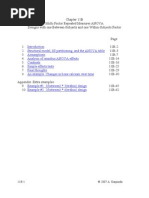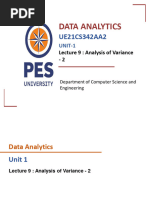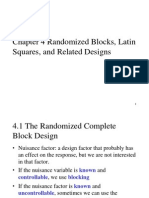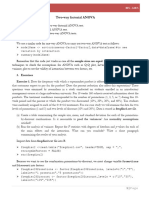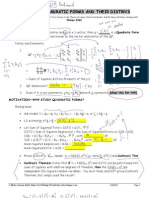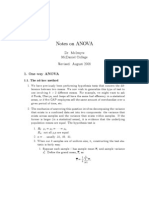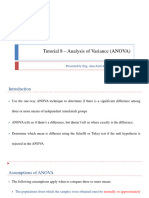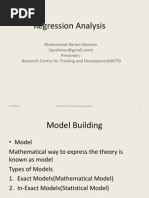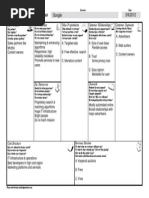Introduction To Two-Way ANOVA
Introduction To Two-Way ANOVA
Uploaded by
jubatus.libroCopyright:
Available Formats
Introduction To Two-Way ANOVA
Introduction To Two-Way ANOVA
Uploaded by
jubatus.libroOriginal Title
Copyright
Available Formats
Share this document
Did you find this document useful?
Is this content inappropriate?
Copyright:
Available Formats
Introduction To Two-Way ANOVA
Introduction To Two-Way ANOVA
Uploaded by
jubatus.libroCopyright:
Available Formats
Introduction
R Exercises
Homework
Introduction
R Exercises
Homework
Introduction to Two-Way ANOVA
In a two-way analysis of variance we analyze the dependence
of a continuous response on two, cross-classied factors.
Two-Way Analysis of Variance: ANOVA
Dr. J. Kyle Roberts
Southern Methodist University Simmons School of Education and Human Development Department of Teaching and Learning
The factors can be experimental factors that are both of
interest or they can be one experimental factor and one blocking factor.
A blocking factor is a known source of variability, such as the
subject or, more generally, the experimental unit. We expect this factor to account for a substantial portion of the variability in the response. We wish to control for this variability but are not interested in comparing the particular levels of this factor.
A cross-classied experiment is said to be balanced if every
pair of conditions occurs the same number of times. You can check with the xtabs function.
Introduction
R Exercises
Homework
Introduction
R Exercises
Homework
Hypothesis Test in Two-Way ANOVA
Recall that the null hypothesis for a one-way ANOVA can be
How the Data are Analyzed in a Two-Way
written as: H0 : Y 1 = Y 2 = Y 3
For the two-way ANOVA, we have the potential to test three For heuristic purposes, suppose that we have a dataset with
two independent variables each with two levels.
In a full factorial setting, we would view this data as:
separate hypothesis tests: one for each way and one for the interaction eect. We do not have to test all 3, but if we do, we refer to this as a full factorial ANOVA.
These hypotheses are:
Levels of First IV
H0:M ainA : 1. = 1. = = j. H0:M ainB : .1 = .2 = = .k H0:ABInteraction : 11 = 12 = 21 = 22 = = jk
where j are the rows and k are the columns.
a1 a2 Mean
Levels of Second IV b1 b2 11 12 X X 21 22 X X .1 .2 X X
Mean 1. X 2. X X
Introduction
R Exercises
Homework
Introduction
R Exercises
Homework
The Two-Way ANOVA Summary Table
Source Main A Main B ABInter. Error Total SS df kA 1 kB 1 dfA dfB dft dfA dfB dfAB n1 MS
SSA dfA SSB dfB SSAB dfAB SSe dfe
Two-Way ANOVA Practice
p 2
SSA SSt SSB SSt SSAB SSt
F
M SA M Se M SB M Se M SAB M Se
Fill in the Missing Values Below. Use pf to compute p.
The statistical signicance of F can be obtained by
Source Main A Main B ABinter Error Total
SS
df 5 4
MS
0.22 600 752 2 0.11 0.08 0.04
computing the F -critical value. Determining statistical signicance follows the same pattern for the t test only we have two sources of df : between and within.
For the two-way ANOVA, the df needed for testing that eect
Fill in the Missing Values Below. Use pf to compute p.
are the df due to that eect and the dferror . Therefore, the df numerator could be dierent for each eect.
Source Main A Main B ABinter Error Total
SS 80
df
MS 40
22 437
Introduction
R Exercises
Homework
Introduction
R Exercises
Homework
Partitioning the Sum of Squares
J
Two-Way ANOVA Data
Read in a table using read.table which resides on this website
SSA = nK
j =1 K
)2 j. X (X .k X )2 (X j. X .k X )2 jk X (X
at http://faculty.smu.edu/kyler/courses/7311/twoway1.txt
Make sure that you include header=T > head(twoway)
1 2 3 4 5 6 gender program gre 2 1 24 2 1 27 2 1 33 2 1 25 2 1 26 2 1 30
SSB = nJ
k=1 K J
SSAB = n
k=1 j =1 K J
SSError =
k=1 j =1 i=1 K J n
jk )2 (Xijk X )2 (Xijk X
k=1 j =1 i=1
> str(twoway)
data.frame: 48 $ gender : int $ program: int $ gre : int obs. of 3 variables: 2 2 2 2 2 2 2 2 1 1 ... 1 1 1 1 1 1 1 1 1 1 ... 24 27 33 25 26 30 22 29 33 26 ...
SST otal =
Introduction
R Exercises
Homework
Introduction
R Exercises
Homework
Structuring and viewing data
Program vs. Gender
> barplot(tapply(twoway$gre, list(twoway$program, twoway$gender), + mean), beside = T, col = rainbow(3))
data.frame: 48 obs. of 3 variables: $ gender : Factor w/ 2 levels "1","2": 2 2 2 2 2 2 2 2 1 1 ... $ program: Factor w/ 3 levels "1","2","3": 1 1 1 1 1 1 1 1 1 1 ... $ gre : int 24 27 33 25 26 30 22 29 33 26 ...
> table(twoway$gender, twoway$program)
1 2 3 1 8 8 8 2 8 8 8
10 0 5
15
20
25
30
> twoway$gender <- factor(twoway$gender) > twoway$program <- factor(twoway$program) > str(twoway)
Introduction
R Exercises
Homework
Introduction
R Exercises
Homework
Interaction Plot
> interaction.plot(twoway$gender, twoway$program, twoway$gre)
Running the Data
> m1 <- aov(gre ~ gender + program, twoway) > summary(m1)
32
twoway$program 3 1 2
mean of twoway$gre
gender program Residuals
Df Sum Sq Mean Sq F value Pr(>F) 1 38.52 38.521 2.2942 0.1370 2 60.67 30.333 1.8066 0.1762 44 738.79 16.791
30
31
> m2 <- aov(gre ~ gender * program, twoway) > summary(m2)
Df Sum Sq Mean Sq F value Pr(>F) gender 1 38.52 38.521 2.5839 0.11544 program 2 60.67 30.333 2.0347 0.14340 gender:program 2 112.67 56.333 3.7788 0.03097 Residuals 42 626.12 14.908
27
28
29
1 twoway$gender
Introduction
R Exercises
Homework
Introduction
R Exercises
Homework
Testing Assumptions
> bartlett.test(gre ~ gender * program, twoway)
Bartlett test of homogeneity of variances data: gre by gender by program Bartletts K-squared = 3.865, df = 1, p-value = 0.0493 Tables of means Grand mean 27.85417 gender gender 1 2 26.958 28.750
Investigation of Means
> model.tables(m2, "means")
> bartlett.test(gre ~ program * gender, twoway)
Bartlett test of homogeneity of variances data: gre by program by gender Bartletts K-squared = 6.5532, df = 2, p-value = 0.03776
> fligner.test(gre ~ gender * program, twoway)
Fligner-Killeen test of homogeneity of variances data: gre by gender by program Fligner-Killeen:med chi-squared = 1.6152, df = 1, p-value = 0.2038
program program 1 2 3 27.187 26.938 29.437 gender:program program gender 1 2 3 1 27.38 27.12 26.37 2 27.00 26.75 32.50
Introduction
R Exercises
Homework
Introduction
R Exercises
Homework
Post Hoc Tests
> TukeyHSD(m2)$"gender:program"
2:1-1:1 1:2-1:1 2:2-1:1 1:3-1:1 2:3-1:1 1:2-2:1 2:2-2:1 1:3-2:1 2:3-2:1 2:2-1:2 1:3-1:2 2:3-1:2 1:3-2:2 2:3-2:2 2:3-1:3 diff -0.375 -0.250 -0.625 -1.000 5.125 0.125 -0.250 -0.625 5.500 -0.375 -0.750 5.375 -0.375 5.750 6.125 lwr -6.13810348 -6.01310348 -6.38810348 -6.76310348 -0.63810348 -5.63810348 -6.01310348 -6.38810348 -0.26310348 -6.13810348 -6.51310348 -0.38810348 -6.13810348 -0.01310348 0.36189652 upr 5.388103 5.513103 5.138103 4.763103 10.888103 5.888103 5.513103 5.138103 11.263103 5.388103 5.013103 11.138103 5.388103 11.513103 11.888103 p adj 0.99995875 0.99999450 0.99949105 0.99516934 0.10654536 0.99999983 0.99999450 0.99949105 0.06898988 0.99995875 0.99876887 0.08000676 0.99995875 0.05082404 0.03144884
In-Class Assignment
Run a two-way ANOVA with the following dataset
GT
Regular
Special Ed.
Teaching Method 1 2 3 40 32 30 36 29 35 38 36 33 24 20 18 21 29 26 20 25 26 22 20 18 18 18 14 16 19 19
Introduction
R Exercises
Homework
Take-Home Assignment
1. Create a dataset of no less than 20 people with two categorical/grouping/independent variables and one dependent variable. Make the dataset a 4x2 design. Create the dataset in such a way that the main eect for the rst way is not statistically signicant, the main eect for the second way is not statistically signicant, but the interaction eect is statistically signicant. 2. Create a dataset of no less than 20 people with two categorical/grouping/independent variables and one dependent variable. Make the dataset a 4x2 design. Create the dataset in such a way that the main eect for the rst way is statistically signicant, the main eect for the second way is statistically signicant, but the interaction eect is not statistically signicant.
You might also like
- Discrete Random Variables and Probability DistributionsDocument36 pagesDiscrete Random Variables and Probability DistributionskashishnagpalNo ratings yet
- Correlation and Regression AnalysisDocument23 pagesCorrelation and Regression AnalysisMichael EdwardsNo ratings yet
- Repeated Measure ANOVA - Between and Within SubjectsDocument85 pagesRepeated Measure ANOVA - Between and Within SubjectsFenil ShahNo ratings yet
- Chapter 10 Simple Linear Regression and CorrelationDocument28 pagesChapter 10 Simple Linear Regression and CorrelationchrisadinNo ratings yet
- UE21CS342AA2 - Unit-1 Part - 3Document90 pagesUE21CS342AA2 - Unit-1 Part - 3abhay spamNo ratings yet
- BSB321 Factorial 2023Document25 pagesBSB321 Factorial 2023Faith MasalilaNo ratings yet
- Abid ResearchMethods VadodraDocument71 pagesAbid ResearchMethods VadodraVivek SharmaNo ratings yet
- Stat Slides 5Document30 pagesStat Slides 5Naqeeb Ullah KhanNo ratings yet
- Learning Outcome 2 - Ac 2 (Analytical Methods)Document7 pagesLearning Outcome 2 - Ac 2 (Analytical Methods)Chan Siew ChongNo ratings yet
- Chi-Square, F-Tests & Analysis of Variance (Anova)Document37 pagesChi-Square, F-Tests & Analysis of Variance (Anova)MohamedKijazyNo ratings yet
- Hierarchical Nested Anova 121Document22 pagesHierarchical Nested Anova 121Vladimiro Ibañez QuispeNo ratings yet
- Notes 9Document57 pagesNotes 9blobofrandomstuffNo ratings yet
- Ken Black QA ch10Document47 pagesKen Black QA ch10Rushabh VoraNo ratings yet
- Demand Forecasting InformationDocument66 pagesDemand Forecasting InformationAyush AgarwalNo ratings yet
- Angga Yuda Alfitra - Ujian Praktikum Rancob - AET3Document11 pagesAngga Yuda Alfitra - Ujian Praktikum Rancob - AET3Muhammad FaisalNo ratings yet
- Chi Square TestDocument32 pagesChi Square Testshubendu ghoshNo ratings yet
- Mel705 14Document40 pagesMel705 14hamza A.laftaNo ratings yet
- SP2009F - Lecture03 - Maximum Likelihood Estimation (Parametric Methods)Document23 pagesSP2009F - Lecture03 - Maximum Likelihood Estimation (Parametric Methods)César Isabel PedroNo ratings yet
- RSK TestDocument5 pagesRSK TestMaria HossainNo ratings yet
- ANOVA MaizeDocument9 pagesANOVA MaizeMuhammad AliNo ratings yet
- 2015 Hw1011 KeyDocument5 pages2015 Hw1011 KeyPiNo ratings yet
- Polynomial Curve FittingDocument44 pagesPolynomial Curve FittingHector Ledesma IIINo ratings yet
- 15 Anova-IiDocument23 pages15 Anova-IiSOBHIT SNo ratings yet
- ANOVA CottonDocument13 pagesANOVA CottonMuhammad AliNo ratings yet
- Chapter 4 Randomized Blocks, Latin Squares, and Related DesignsDocument34 pagesChapter 4 Randomized Blocks, Latin Squares, and Related DesignsBalaji GaneshNo ratings yet
- Statistics and Probability Finals Week 1.3Document16 pagesStatistics and Probability Finals Week 1.3venveneciNo ratings yet
- Econometrics ExamDocument8 pagesEconometrics Examprnh88No ratings yet
- ME361 - Manufacturing Science Technology: Measurements and MetrologyDocument20 pagesME361 - Manufacturing Science Technology: Measurements and MetrologyKartikeyaNo ratings yet
- BES - R Lab 5Document7 pagesBES - R Lab 5nguyenthihuong120304No ratings yet
- No Linealidades Stock WatsonDocument59 pagesNo Linealidades Stock WatsonjlcastlemanNo ratings yet
- Topic 11: Statistics 514: Design of ExperimentsDocument34 pagesTopic 11: Statistics 514: Design of ExperimentsJim JarNo ratings yet
- Chapter 2Document30 pagesChapter 2MengHan LeeNo ratings yet
- Nested Designs: Study Vs Control SiteDocument13 pagesNested Designs: Study Vs Control SiteHasrul MuhNo ratings yet
- Ch17 Curve FittingDocument44 pagesCh17 Curve FittingSandip GaikwadNo ratings yet
- 2024 Module Test 2 - 2Document6 pages2024 Module Test 2 - 24219531No ratings yet
- Introduction SPCDocument28 pagesIntroduction SPCmixarimNo ratings yet
- Copy of Assignment5_Fall 2024Document14 pagesCopy of Assignment5_Fall 2024joy kawinoNo ratings yet
- Notes On Anova: Dr. Mcintyre Mcdaniel College Revised: August 2005Document10 pagesNotes On Anova: Dr. Mcintyre Mcdaniel College Revised: August 2005Usha Janardan MishraNo ratings yet
- Tutorial 8 - Analysis of Variance (ANOVA) : Presented by Eng. Alaa Zarif & Eng. Lobna El SeifyDocument19 pagesTutorial 8 - Analysis of Variance (ANOVA) : Presented by Eng. Alaa Zarif & Eng. Lobna El SeifyAhmed BadrNo ratings yet
- PBD Report FinalDocument20 pagesPBD Report FinalNandhini LaxmanNo ratings yet
- Quantitative Techniques - Ii: Dr. Pritha GuhaDocument27 pagesQuantitative Techniques - Ii: Dr. Pritha GuhaPradnya Nikam bj21158No ratings yet
- Modeling and Analyzing System Behavior: February 25, 2013Document88 pagesModeling and Analyzing System Behavior: February 25, 2013elvagojpNo ratings yet
- Ch17 Curve FittingDocument44 pagesCh17 Curve Fittingvarunsingh214761No ratings yet
- Regression Analysis (Cases 1-3)Document42 pagesRegression Analysis (Cases 1-3)saeedawais47No ratings yet
- ANOVA SorghumDocument7 pagesANOVA SorghumMuhammad AliNo ratings yet
- Some Advanced Topics Using Propagation of Errors and Least Squares FittingDocument8 pagesSome Advanced Topics Using Propagation of Errors and Least Squares FittingAlessandro TrigilioNo ratings yet
- AnnovaDocument19 pagesAnnovaLabiz Saroni Zida0% (1)
- The Growth of Functions: Rosen 2.2Document36 pagesThe Growth of Functions: Rosen 2.2Luis LoredoNo ratings yet
- 08 DCM Induced PhaseDocument37 pages08 DCM Induced PhaseAmir MotakefNo ratings yet
- U5 2-RandomizedBlockDesignsDocument21 pagesU5 2-RandomizedBlockDesignsMuhammad Naeem IqbalNo ratings yet
- Copy of Hints of Assignment5_Fall 2024Document11 pagesCopy of Hints of Assignment5_Fall 2024joy kawinoNo ratings yet
- Assignment 2 AnswersDocument18 pagesAssignment 2 AnswersIvonne NavasNo ratings yet
- Formula CardDocument13 pagesFormula CardDasaraaaNo ratings yet
- Pertemuan 3 AnovaDocument60 pagesPertemuan 3 AnovaKerin ArdyNo ratings yet
- Student's Solutions Manual and Supplementary Materials for Econometric Analysis of Cross Section and Panel Data, second editionFrom EverandStudent's Solutions Manual and Supplementary Materials for Econometric Analysis of Cross Section and Panel Data, second editionNo ratings yet
- Sample Size for Analytical Surveys, Using a Pretest-Posttest-Comparison-Group DesignFrom EverandSample Size for Analytical Surveys, Using a Pretest-Posttest-Comparison-Group DesignNo ratings yet
- Student Solutions Manual to Accompany Economic Dynamics in Discrete Time, second editionFrom EverandStudent Solutions Manual to Accompany Economic Dynamics in Discrete Time, second editionRating: 4.5 out of 5 stars4.5/5 (2)
- Application of Derivatives Tangents and Normals (Calculus) Mathematics E-Book For Public ExamsFrom EverandApplication of Derivatives Tangents and Normals (Calculus) Mathematics E-Book For Public ExamsRating: 5 out of 5 stars5/5 (1)
- Compost For Erosion ControlDocument9 pagesCompost For Erosion Controljubatus.libroNo ratings yet
- Measuring Transcriptomes With RNA-SeqDocument48 pagesMeasuring Transcriptomes With RNA-Seqjubatus.libroNo ratings yet
- RNA SeqDocument31 pagesRNA Seqjubatus.libroNo ratings yet
- RNA-Seq Analysis CourseDocument40 pagesRNA-Seq Analysis Coursejubatus.libroNo ratings yet
- Perspectives: Rna-Seq: A Revolutionary Tool For TranscriptomicsDocument7 pagesPerspectives: Rna-Seq: A Revolutionary Tool For Transcriptomicsjubatus.libroNo ratings yet
- Inia 2011. Medrano Inia2011 RnaseqDocument23 pagesInia 2011. Medrano Inia2011 Rnaseqjubatus.libroNo ratings yet
- Peru Market Assessment Sector MappingDocument67 pagesPeru Market Assessment Sector Mappingjubatus.libroNo ratings yet
- Diff Expr NgsDocument29 pagesDiff Expr Ngsjubatus.libroNo ratings yet
- Methane Vs Propane C11!2!09Document11 pagesMethane Vs Propane C11!2!09jubatus.libroNo ratings yet
- Literature Review and Road Map For Using Biogas in Internal Combustion EnginesDocument10 pagesLiterature Review and Road Map For Using Biogas in Internal Combustion Enginesjubatus.libroNo ratings yet
- Literature Review and Road Map For Using Biogas in Internal Combustion EnginesDocument10 pagesLiterature Review and Road Map For Using Biogas in Internal Combustion Enginesjubatus.libroNo ratings yet
- A Free Best Practice Guide On Effective Gas Flow CalibrationDocument7 pagesA Free Best Practice Guide On Effective Gas Flow Calibrationjubatus.libroNo ratings yet
- 015 Icbem2012 C00002Document6 pages015 Icbem2012 C00002jubatus.libroNo ratings yet
- Biochemical Methane Potential of Different Organic Wastes and Energy Crops From EstoniaDocument12 pagesBiochemical Methane Potential of Different Organic Wastes and Energy Crops From Estoniajubatus.libroNo ratings yet
- In Vitro Gas Fermentation of Sweet Ipomea Batatas) and Wild Cocoyam (Colocasia Esculenta) PeelsDocument4 pagesIn Vitro Gas Fermentation of Sweet Ipomea Batatas) and Wild Cocoyam (Colocasia Esculenta) Peelsjubatus.libroNo ratings yet
- Skype Business ModelDocument1 pageSkype Business Modeljubatus.libroNo ratings yet
- Nitendo Wii Business ModelDocument1 pageNitendo Wii Business Modeljubatus.libroNo ratings yet
- Google Business ModelDocument1 pageGoogle Business Modeljubatus.libroNo ratings yet
- ANOVA in RDocument7 pagesANOVA in Rjubatus.libroNo ratings yet



